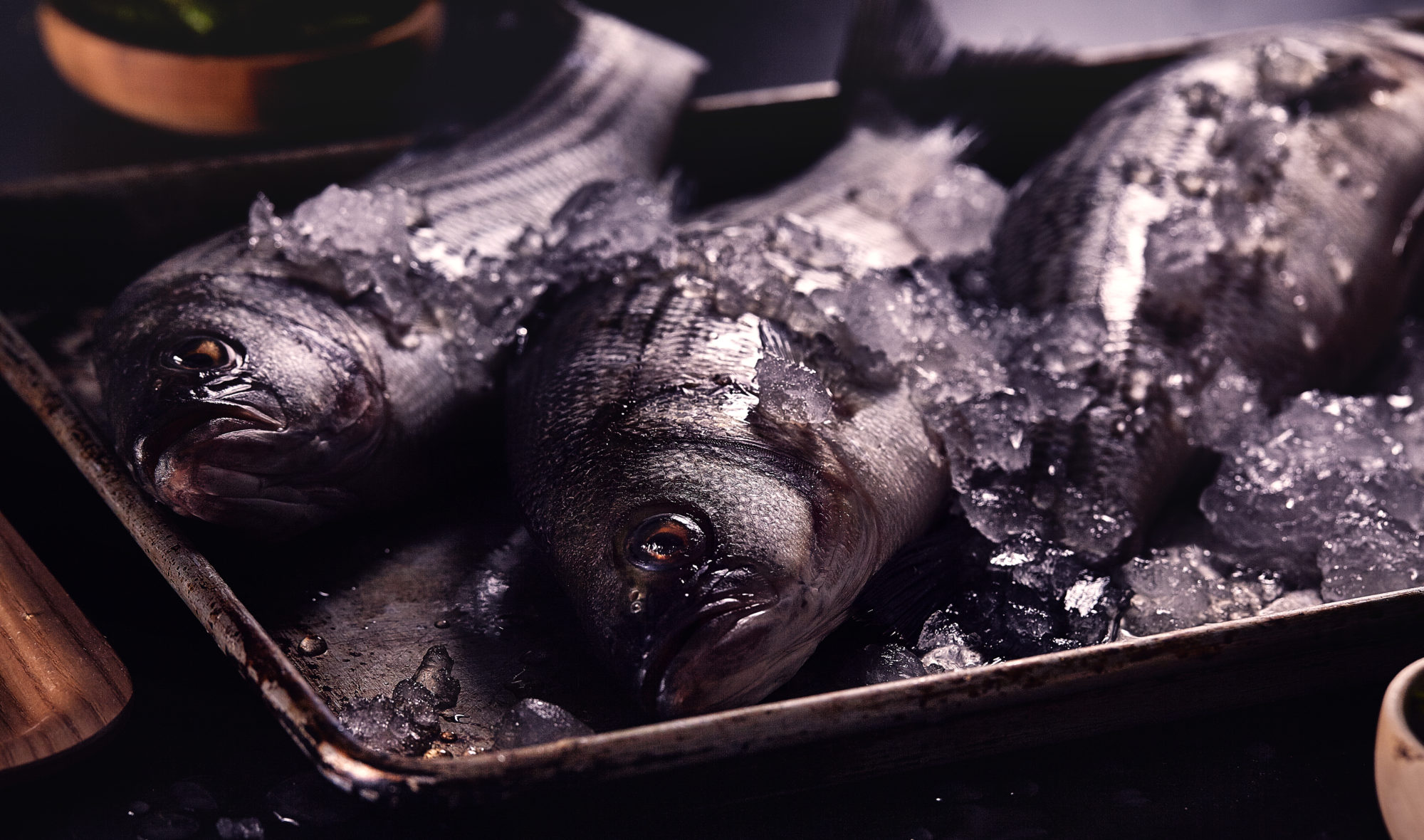Bass


The term “bass” refers to not one, but many varieties of fish. Although varied in terms of genus, appearance, geographical origin, and freshwater vs saltwater preference, bass have some common features: Most bass fish have delicately flavored white flesh, and a feisty, predatory attitude. Because they are both a delicious catch and a challenging fighting opponent, bass are a favorite target among sport fishermen. Commercially speaking, bass sourced from the sea tends to be more popular than bass from freshwater sources, as the latter tend to be prone to muddy flavors. Bass is lean fish and is an excellent source of protein and a good source of B12. Its neutral flavor means that it is adaptable to a variety of recipes.
Now here’s a twist: The term “bass” is used to describe not one, but several fairly different species of fish.
Fish answering to the name “bass” can belong to the following families:
Moronidae: Also known as temperate basses or “true” basses, this family includes European sea bass, white bass, and striped bass. Fish in the Moronidea family tend to be found in the coastal regions of eastern North America, Europe, and North Africa.
Centrarchidae: Also known as black basses, this family includes the Choctaw bass, Guadalupe bass, largemouth bass, smallmouth bass, rock bass, and spotted bass. Most of these are native only to North America.
Lateolabracidae: Also known as Asian sea basses, this family includes Japanese sea bass and blackfin sea bass. Fish in the Lateolabracidae family dwell in the coastal waters of the western Pacific Ocean.
Although there are other kinds of bass that belong to other families (like Chilean sea bass from the Nototheniidae family or black seabass from the Serranidae family), we don’t have all day (taxonomy is complicated).
Depending on the species, bass can be found in freshwater or saltwater environments. Freshwater bass is rarely sold commercially as it is prone to muddy flavors.
Bass tend to be feisty, predatory fish, often with a row of pointy teeth. Because they put up a good fight and look rather intimidating, bass are a favorite opponent among sport fishermen.
The appearance and flavor of bass will vary depending on the species.
Generally, bass has white flesh with a delicate flavor.
Because of its mild flavor, bass tends to absorb the flavors from its environment, therefore bass sourced from polluted or freshwater areas can taste muddy or swampy. For this reason, most bass sold commercially will come from the sea, giving the fish a cleaner, oceanic flavor.
Three ounces of cooked sea bass (about 85g) has 105 calories, 20.1g of protein, 2.2g of fat, and no carbohydrates, fiber, or sugar. Bass is a good source of B12.
As with most seafood purchases, when selecting bass, shop at quality stores you trust. A good fish monger should be able to tell you about the fish you are purchasing: what species it is, when and where it was fished, and how to store and prepare it.
Bass can be found fresh or frozen, and is typically sold in fillets. The skin may be on or it may be removed. Most cooks prefer skin-on varieties. Although it is not usually eaten, the skin helps the fish keep its integrity during the cooking process.
Fresh bass should be displayed over ice and should look moist, but not wet, with little separation between the muscle fibers. If you can, give it a sniff. Fresh fish should have a pleasant oceanic smell. It should not smell overly strong or offensive.
Trust your nose. If it smells “off”, look elsewhere.
The length of time fresh bass can be stored depends on when the fish was caught, but if you don’t have the catch date, keep it the fridge in an airtight container, and eat it within a day or two.
Bass can also be frozen for up to three months. Wrap it well to protect it from freezer burn.
Once it’s cooked, bass can be kept in an airtight container in the fridge for five to six days, or in the freezer for up to three months.
Like most fish, fresh bass cooks quickly and easily. If your bass is from clean waters, its delicately flavored flesh will need minimal seasoning (a little butter, lemon, and salt is great). However, also because of its delicate, neutral flavor, bass is a versatile fish that marries well with many different flavors such as curries, tomato-based sauces, and a variety of fresh herbs.
Bass can be pan-fried, baked, poached, or cooked in a stew, but pan-frying is among the fastest and easiest.
Here’s how to do it:
Use a paper towel to pat the fish dry on both sides. This will help the fish brown and caramelize. Sprinkle both sides lightly with salt and pepper.
Then, place a bit of butter or olive oil in a non-stick pan and heat over medium-high heat. When a flick of water sizzles when it meets the pan, the fish may be added to the pan.
Allow the fish to cook on one side for about three to four minutes. Then, flip the fish and cook on the other side for another few minutes, depending on the thickness of the filet.
On the stove top, fresh or thawed bass takes about 7 minutes to cook per one inch of thickness.
When the fish is ready, it will be opaque and white and the flesh will flake easily. Top with a squeeze of lemon and your choice of additional seasoning if desired, and serve immediately.

This roasted sea bass dish is full of bold flavor. Jalapeños, ginger, and lime give this delicate white fish some kick, fresh chopped herbs add freshness, and chopped peanuts add crunch.
Prep Time: 15 minutes Cook Time: 20 minutes Yield: 4 servings
Preheat oven to 350°F. Add lime juice, fish sauce, and honey to a small bowl and whisk to combine. Set aside.
Add two tablespoons of oil to a large ovenproof skillet over medium-high heat. Wait until oil is sizzling, then place fillets in the pan, skin side down, and cook until skin is golden brown and crisp, about 5–7 minutes. Transfer skillet to oven and roast, about 5-8 minutes. Fish is done when it is just opaque in the center and flakes easily with a fork.
While fish is roasting, heat remaining two tablespoons of oil in another large skillet over medium-high heat. Add red onion, ginger, jalapeño, and garlic, and cook until fragrant, stirring often, about 3 minutes. Add reserved lime, fish sauce, and honey mixture to skillet and cook for an additional minute or two. Remove from heat and pour over cooked fish fillets. Top with sliced green onions, chopped herbs, and peanuts, then serve.
Precision Nutrition’s Encyclopedia of Food expands every single month as we highlight new foods and showcase beautiful food photography. If you’d like to stay up to date, simply click this link. From there, we’ll send you a FREE copy of our recipe book. We’ll also let you know when new and delicious foods are added to the site.
The term “bass” refers to not one, but many varieties of fish. Although varied in terms of genus, appearance, geographical origin, and freshwater vs saltwater preference, bass have some common features: Most bass fish have delicately flavored white flesh, and a feisty, predatory attitude. Because they are both a delicious catch and a challenging fighting opponent, bass are a favorite target among sport fishermen. Commercially speaking, bass sourced from the sea tends to be more popular than bass from freshwater sources, as the latter tend to be prone to muddy flavors. Bass is lean fish and is an excellent source of protein and a good source of B12. Its neutral flavor means that it is adaptable to a variety of recipes.